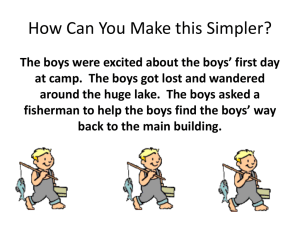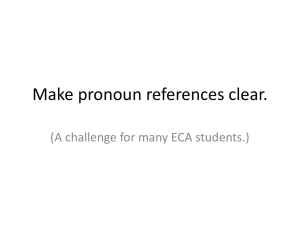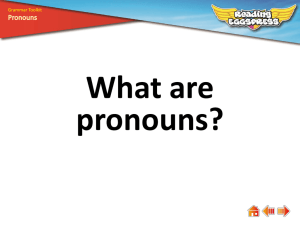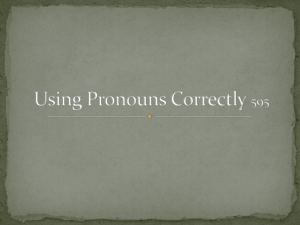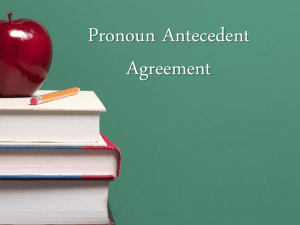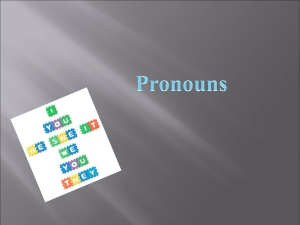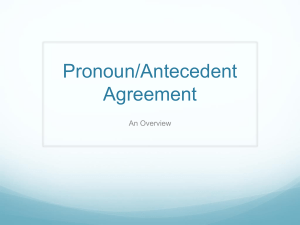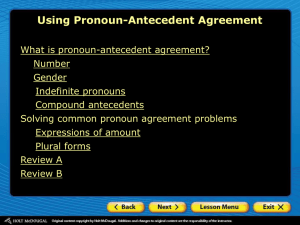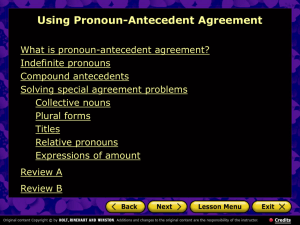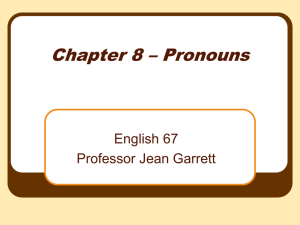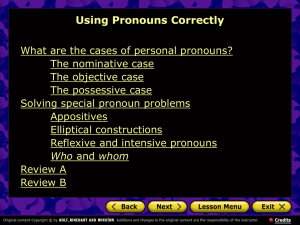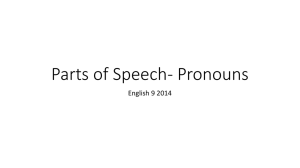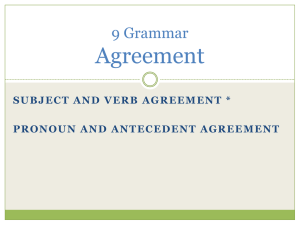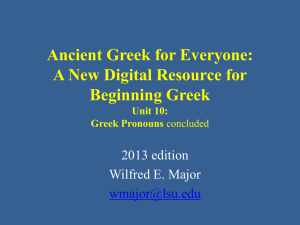2nd Tri Grammar PPT
advertisement
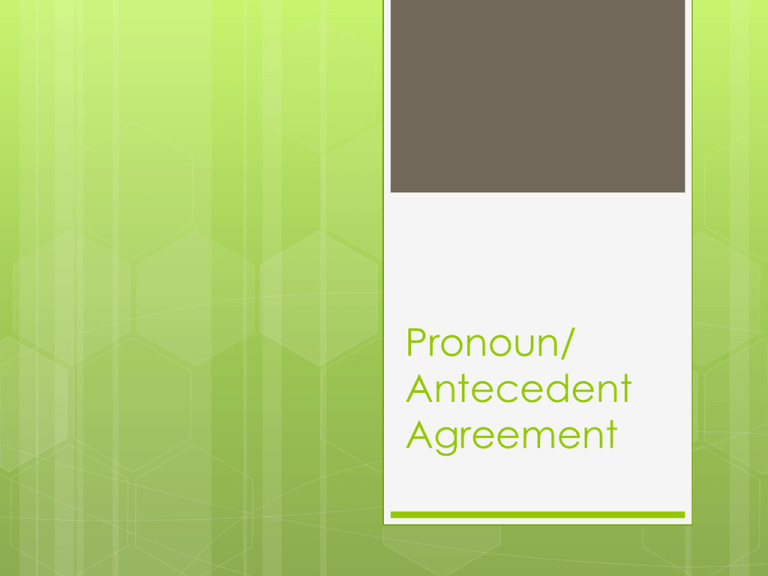
Pronoun/ Antecedent Agreement Definitions Pronoun = word that refers to another noun (he, she, it, they, my, your, etc.) Antecedent refers. = noun to which the pronoun Sally (Ant.) drank her (Pro.) milk slowly. Rule 1 A pronoun should agree in number, gender, and person with its antecedent. Agreement in Number • • Singular: Sammy Davis Jr. made his movie debut in 1931. Plural: The hikers took their canteens with them. Agreement in Gender • • Gender Pronouns: he, him, his, himself, she, her, hers, herself Neither Masculine nor Feminine: it, its, and itself Agreement in Person First: I need a transcript of my grades. Second: Have you fastened your seat belt? Third: He said they made their own costumes. Third person can be singular or plural Singular = he/him/his, she/her/hers Plural = they/their Rule 2 Using indefinite pronouns as part of the antecedent may require a single or plural pronoun, or sometimes could use either, depending on meaning. Indefinite pronouns in antecedent = single, plural, or both Singular Anybody,,, each, either, everybody, neither, nobody, somebody Both all, any, more, most, none, some Plural both, few, many, and several Chart of Indefinite Pronouns ***Gender neutral pronouns ***If the subject is countable, use a plural pronoun. If the subject is uncountable, use a singular pronoun. Examples using indefinite pronouns Singular example: Each of the boys brought his own mitt. Plural example If the antecedent may be either gender, use both. EX: Any interested person may send his or her resume. Both of the debaters persuasively presented their arguments. Both example Some of the students did their homework. All of the sugar fell out of its bag. Rule 3 Use a plural pronoun to refer to two or more antecedents joined by “and”. If Joann and Ben call, tell them that I will not be home until this evening. Antecedents joined by “and” may name only one person, place, thing, or idea The corned beef and cabbage was delicious; I ate two servings of it. Rule 4 Use a singular pronoun to refer to two or more singular antecedents joined by or or nor. Neither Cindy nor Carla thinks she is ready to audition. Practice Exercise 13 page 538 1-10: Write the pronoun that completes the sentence Problems with Pronoun/ Antecedent Agreement Rule #5 A collective noun can be either singular or plural, depending on how it is used Singular: refers to the group as a unit The committee comprised three juniors and two seniors; its chairperson was Angelo. [Angelo was chairperson of the committee as unit] Plural: refers to the individual members or part of the group The committee discussed their varied schedules. [The members of the committee had different schedules.] Rule #6 Some antecedents require singular pronouns, even though they look plural Civics Measles Molasses Economics Mumps Electronics News Genetics Physics Gymnastics Summons Mathematics I’m looking forward to studying physics next year; it is my favorite subject. Rule #6 Cont. Some nouns take plural pronouns even when they refer to single items Binoculars Pants Shears Eyeglasses Pliers Shorts Olympics Slacks Scissors Whenever the Olympics are held, they attract athletes from all over the world. I have misplaced my eyeglasses. Have you seen them? Rule #7 An expression of an amount (a measurement, a percentage, or a fraction) may be singular or plural, depending on how it is used. Five thousand bricks is a heavy load; it almost ruined the truck’s suspension. [The bricks are thought of a unit (one load)] Two thirds of the apples are rotten; they should be thrown out. [The fraction refers to the plural noun apples] Practice Pg. 539 Exercise H: EVEN NUMBERS ONLY You do NOT have to write the whole sentence EVERY sentence has an error. Pronoun Case and Reference Definition Case: the form that a noun or a pronoun takes to show its relationship to other words in a sentence Nominative/Subjective (subject of sentence) Objective (object of sentence) Possessive (showing possession) Examples The general explained the strategy [nominative subject]. The strategy was explained by the general [objective object]. The general’s explanation was both clear and concise [possessive]. Copy chart on pg. 548 of your textbook into your notes Rule 1 Nominative Case is used when the pronoun is the subject of the verb. We ordered the concert tickets [We is the subject of the verb ordered]. Tip: find the verb first, to decide what pronoun is in the nominative case. Rule 2 A personal pronoun used as a predicate nominative usually completes the meaning of a form of the verb “be”: am, is, are, was, were, be, been, or being The chairperson of the prom committee is she. The one who made the comment was I. Tip: find the “be” verb first, then the pronoun that follows. Rule 3 A direct and indirect object should be in the objective case. My pen pal from Manila visited me last summer. The coach awarded her a varsity letter. Tip: remember that the object of a sentence answers the question “who?” as well as “to whom?” or “for whom?” Rule 4 Possessive pronouns can be used in the same ways as nominative and objective. Your car and mine need to be washed [nominative]. Mrs. Fong takes hers for a walk twice a day [objective]. Rule 5 A pronoun ending in –self or –selves should not be used in place of a personal pronoun Did Rosa make lunch for herself and yourself [incorrect]? Did Rosa make lunch for herself and you [correct]? Tip: Remove the other –self or –selves pronoun, and see what makes sense, Rule 6 Who vs. whom “Who” is always a subject and is followed by a verb. “Whom” is an object Examples Who wants some key lime pie? Nortel hired whom? She works for whom? Notice that “whom” may come after a verb or a preposition. Tricks for deciding If you could substitute “he/she” and the sentence makes sense, use who. If you could substitute “him/her” and the sentence makes sense, use whom. He wants some key lime pie? Who wants some key lime pie? Nortel hired her? Nortel hired whom? She works for him? She works for whom? Practice Label the pronoun as nominative, objective, or possessive. I passed the class. The teacher gave us homework. The book is theirs. You and I should go to the movie. Practice Fill in the blank with the correct pronoun OR who/whom. With ______ did you go to tolo? (who/whom) ______ told you that rumor? (who/whom) Is this Ms. Eaton? Yes, this is ______. (she/her) Practice Fix the error in the following sentences Did you and her fight? You and me should go to the movie. Me and him snorkeled. Us skiers love cocoa. Her and Ryan are engaged.
